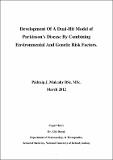| dc.description.abstract | Even though half a century has passed since the discovery of the efficacy of the dopamine precursor, levodopa, it remains the most effective therapy for the motor symptoms of Parkinson's disease to this day, despite its serious side effects. One factor that is thought to have contributed to the paucity of novel therapies for this condition is the lack of relevant animal models. Since Parkinson's disease is thought to arise from complex interactions between genes and the environment, modelling the condition using relevant genetic and environmental risk factors may yield a more relevant model. Thus, the aim of this body of work was to develop a novel model of Parkinson's disease using the disease-associated pesticide, rotenone, and/or virally-mediated overexpression of the disease-associated protein, alpha-synuclein. This was addressed using three main approaches: 1) direct intracerebral infusion of rotenone alone, 2) systemic administration of rotenone combined with intranigral administration of AAV-alpha-synuclein, and 3) intracerebral infusion of rotenone with intranigral administration of AAV-alpha-synuclein. In all studies, the impact of the insults on motor function, nigrostriatal integrity and alpha-synuclein expression were assessed. The main findings were 1) that intracerebral infusion of rotenone induces motor impairments with nigrostriatal degeneration but without any alpha-synucleinopathy, 2) that systemic administration of rotenone with intranigral infusion of AAV-alpha-synuclein can induce the classical features of Parkinson's disease but is associated with peripheral toxicity, and 3) that sequential intranigral infusion of AAV-alpha-synuclein and rotenone leads to progressive motor dysfunction with nigrostriatal degeneration and alpha-synuclein overexpression. Overall, this research has shown that the sequential intranigral dual-hit model provides a relevant and robust Parkinson's disease model, which, with further validation, may be useful for gaining a greater understanding of the complex gene-environment interactions associated with the disease, and also for assessing novel pharmacological, neuroprotective or neuroreparative treatment approaches. | en_US |


